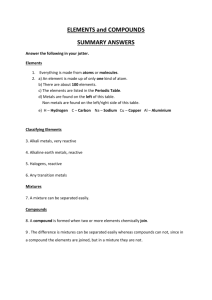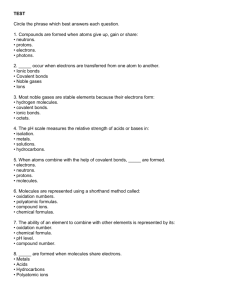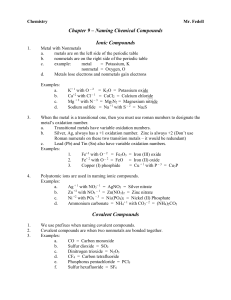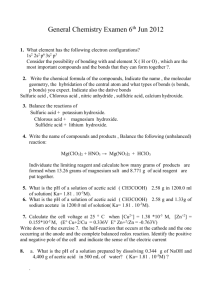Descriptive Chemistry
advertisement
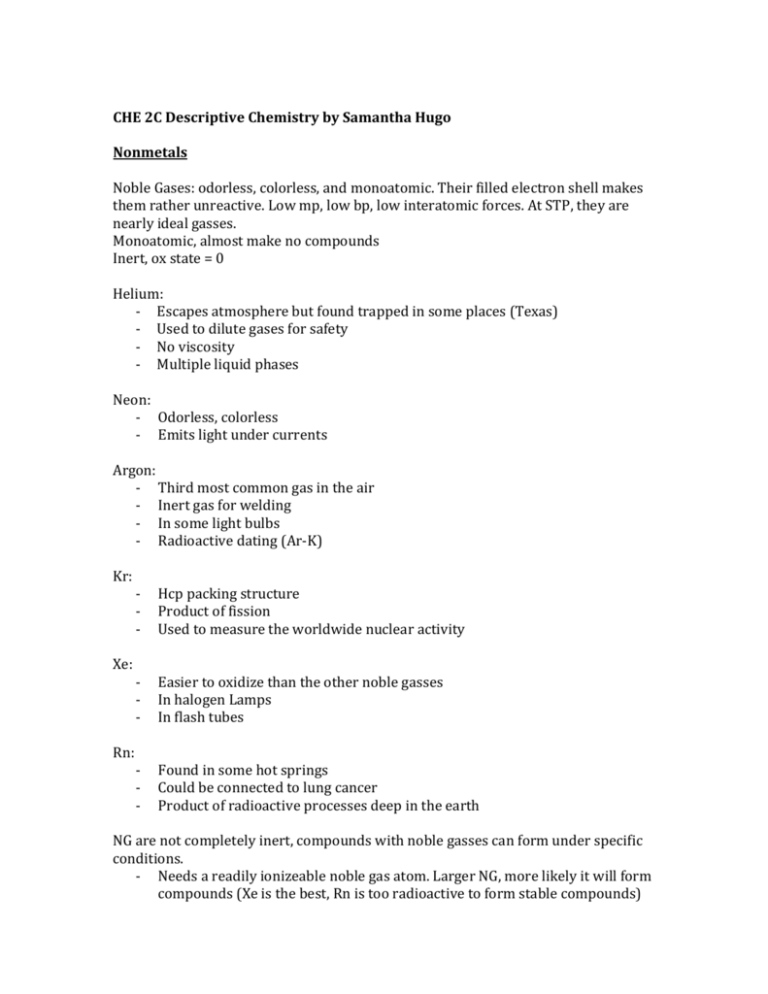
CHE 2C Descriptive Chemistry by Samantha Hugo Nonmetals Noble Gases: odorless, colorless, and monoatomic. Their filled electron shell makes them rather unreactive. Low mp, low bp, low interatomic forces. At STP, they are nearly ideal gasses. Monoatomic, almost make no compounds Inert, ox state = 0 Helium: - Escapes atmosphere but found trapped in some places (Texas) - Used to dilute gases for safety - No viscosity - Multiple liquid phases Neon: - Odorless, colorless - Emits light under currents Argon: - Third most common gas in the air - Inert gas for welding - In some light bulbs - Radioactive dating (Ar-K) Kr: Xe: Rn: - Hcp packing structure Product of fission Used to measure the worldwide nuclear activity - Easier to oxidize than the other noble gasses In halogen Lamps In flash tubes - Found in some hot springs Could be connected to lung cancer Product of radioactive processes deep in the earth NG are not completely inert, compounds with noble gasses can form under specific conditions. - Needs a readily ionizeable noble gas atom. Larger NG, more likely it will form compounds (Xe is the best, Rn is too radioactive to form stable compounds) - High EN to bond with NG (O or F are good) Halogens: - Halogens are referred to as X. Produced industrially through electrolysis or oxidation. Electron configuration = ns2np5. F is the most reactive because it is the most polarizable. I is the least. Diatomic F is most reactive, At is the least Activity Series: More reactivity can replace less reactive in solution F2 is the best ox agent HF is etch glass Colorless, corrosive, nonmetal Found in nature Combined with metals or as pure elements (diatomic) Astatine is not of practical importance because it short lived and radioactive. Halogens form with oxygen to form oxy acids Ex: HOX is hypohalous acid HOXO is halous acid HOXO2 is halic acid HOXO3 is perhalic acid Group 16: Chalcogens O2 and O3 are elemental forms. O3 (ozone) protects from the energy (hv) of harmful UV rays. Energy produced is transferred to N2 in the atmosphere in the form of kinetic energy. Common oxidation states of oxygen are O: O2, +1: peroxides (O22- anion), and +2: most common. Oxygen has two common allotropes O2 (oxygen) and O3 (ozone) Sulfur has many elemental forms, S8 is the most common. The smell of skunks is because of sulfur. Sulfuric acid is used as a fertilizer, wasterwater processing, and mineral processing. Vulcanized rubber used for tires have sulfur bonds. Sulfur is used in hair care products because hair contains S-S bonds. Polymorphs: same bonds, different crystal structures Selenium and Tellurium applications: semiconductors, alloys, glass coloring. Polonium is radioactive. Simple cubic packing structure. Po is in tobacco and may be tied to cancer. Very lethal. Group 15: Pnictogens Exist in multiple oxidation states. Ns2np3 N is either extremely stable or extremely reactive. N2(g) is nearly inert. Used as inert atmosphere for water and oxygen sensitive materials. In air, it prevents explosions by reactions with O2(g) by acting as a diluent. Prevents humans from ODing on O2(g) Nitroglycerin and TNT are nitrogen containing explosives. Exothermic, stable products, fast, and high volume expansion. DNAand nitrogen fixation processes contain nitrogen. NH3 is a fertilizer. N2O is laughing gas and a propellant for whipping cream. P: - +3 and +5 ox states P5 and P2O5 are common compounds Biological compounds: ATP and ADP Fertilizer Arsenic: - Metalloid with various allotropes - Used to strengthen alloys - Semiconductor - Toxic and notoriously in groundwater - Pesticides, herbicides, and insecticides Antimony: - Mined in China - Solders, bullets, bearings, fire retardants Bismuth: - White, silver/ pink hue - Highest atomic mass element that is stable - Low toxicity as a heavy metal, therefore can substitute for lead - Pepto-Bismol, cosmetics, pigments Group 14: Tetragens Carbon: - Forms strong bonds - Cyclic and Acyclic structures - Bond with itself and other atoms - Single and multiple bonds - Allotropes are graphite and diamonds, Buckminster Fullerenes, Nanotubes, and Graphene. - Diamonds are hardest naturally occurring substance - Highest sublimation points of all elements - Graphene: one atom thick sheet of carbon Can form double, triple, ring, chain, and branched chain bonds Diamond is a pure carbon, Crystalline (single molecule), covalent molecules, tetrahedral, high mp, brittle - Buckyballs= fullerenes. Spherical carbon - Nanotubes (carbon fiber): long tubes of individual molecules Silicon: - In glass - Oils, rubber, implants, and high temp lubricants - Components of dust and sand Germanium: - Similar to Sn and Si - Mined from Sphalerite - Semiconductor in transistors, fiber optics, and solar cells Group 13: Boron is electron deficient, incomplete octet. Metalloid/ could be nonmetal. Covalent bonds, but numeroud analogues with transition metals in structure and cluster chemistry. Form dimmers, covalently bonded allotropes, like carbon. Form clusters with 5-12 B atoms. Behaves more like Si than Al. +3 is most common ox state. Hard, brittle, and unreactive. Used as a dopant in the semiconductor industry. Resists to thermal shock . - All possess +1/+3 oxidation states. - High charge density, high polarizing power, covalent bonds - Ns2np1 - All can possess +3 ox state, all but B and Al can be +1 Aluminum - 8.3% of earth’s crust light alloys good in industry Chapter 22 Group 1 has the biggest atomic radius, easiest to ionize (lowest IE). Low densities. First member is the lightest and has different features than the rest of the group. Cations are smaller, anions are larger. Polarizing power is related to charge density (p): charge/ unit volume Increase in charge density, increase in polarizing power (greater ability to distort electron cloud of an anion towards itself) Alkali Metals: Mostly water soluble, very active Big atomic radii= low density, float on H2O. Weak metallic bonding Soft metals, low MP All good reducing agents (good at oxidizing) Very reactive Ns1 Produce H2 with water Can make several compounds with oxygen Shiny soft metals with low mps Not found in nature as free elements Very reactive Form alkaline solution in water Alkaline Earth Metals: Slightly soluble in water. Basic, alkaline More metallic than group 1 Form mostly ionic compounds Decrease ionic size, increase ionic charge Ns2, easy to lose Reactive Good reducing agent All but Be forms hydroxides because Be is a semimetal Lusterous, silvery metals Reactive Not found in nature as free elements

